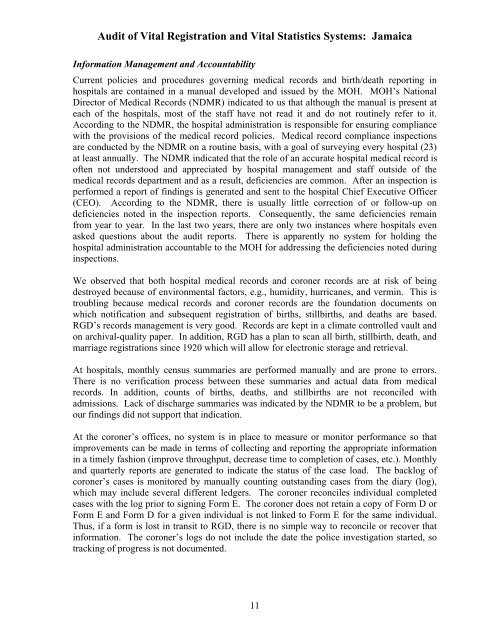Vital Statistics Commission of Jamaica - Planning Institute of Jamaica
Vital Statistics Commission of Jamaica - Planning Institute of Jamaica
Vital Statistics Commission of Jamaica - Planning Institute of Jamaica
Create successful ePaper yourself
Turn your PDF publications into a flip-book with our unique Google optimized e-Paper software.
Audit <strong>of</strong> <strong>Vital</strong> Registration and <strong>Vital</strong> <strong>Statistics</strong> Systems: <strong>Jamaica</strong><br />
Information Management and Accountability<br />
Current policies and procedures governing medical records and birth/death reporting in<br />
hospitals are contained in a manual developed and issued by the MOH. MOH’s National<br />
Director <strong>of</strong> Medical Records (NDMR) indicated to us that although the manual is present at<br />
each <strong>of</strong> the hospitals, most <strong>of</strong> the staff have not read it and do not routinely refer to it.<br />
According to the NDMR, the hospital administration is responsible for ensuring compliance<br />
with the provisions <strong>of</strong> the medical record policies. Medical record compliance inspections<br />
are conducted by the NDMR on a routine basis, with a goal <strong>of</strong> surveying every hospital (23)<br />
at least annually. The NDMR indicated that the role <strong>of</strong> an accurate hospital medical record is<br />
<strong>of</strong>ten not understood and appreciated by hospital management and staff outside <strong>of</strong> the<br />
medical records department and as a result, deficiencies are common. After an inspection is<br />
performed a report <strong>of</strong> findings is generated and sent to the hospital Chief Executive Officer<br />
(CEO). According to the NDMR, there is usually little correction <strong>of</strong> or follow-up on<br />
deficiencies noted in the inspection reports. Consequently, the same deficiencies remain<br />
from year to year. In the last two years, there are only two instances where hospitals even<br />
asked questions about the audit reports. There is apparently no system for holding the<br />
hospital administration accountable to the MOH for addressing the deficiencies noted during<br />
inspections.<br />
We observed that both hospital medical records and coroner records are at risk <strong>of</strong> being<br />
destroyed because <strong>of</strong> environmental factors, e.g., humidity, hurricanes, and vermin. This is<br />
troubling because medical records and coroner records are the foundation documents on<br />
which notification and subsequent registration <strong>of</strong> births, stillbirths, and deaths are based.<br />
RGD’s records management is very good. Records are kept in a climate controlled vault and<br />
on archival-quality paper. In addition, RGD has a plan to scan all birth, stillbirth, death, and<br />
marriage registrations since 1920 which will allow for electronic storage and retrieval.<br />
At hospitals, monthly census summaries are performed manually and are prone to errors.<br />
There is no verification process between these summaries and actual data from medical<br />
records. In addition, counts <strong>of</strong> births, deaths, and stillbirths are not reconciled with<br />
admissions. Lack <strong>of</strong> discharge summaries was indicated by the NDMR to be a problem, but<br />
our findings did not support that indication.<br />
At the coroner’s <strong>of</strong>fices, no system is in place to measure or monitor performance so that<br />
improvements can be made in terms <strong>of</strong> collecting and reporting the appropriate information<br />
in a timely fashion (improve throughput, decrease time to completion <strong>of</strong> cases, etc.). Monthly<br />
and quarterly reports are generated to indicate the status <strong>of</strong> the case load. The backlog <strong>of</strong><br />
coroner’s cases is monitored by manually counting outstanding cases from the diary (log),<br />
which may include several different ledgers. The coroner reconciles individual completed<br />
cases with the log prior to signing Form E. The coroner does not retain a copy <strong>of</strong> Form D or<br />
Form E and Form D for a given individual is not linked to Form E for the same individual.<br />
Thus, if a form is lost in transit to RGD, there is no simple way to reconcile or recover that<br />
information. The coroner’s logs do not include the date the police investigation started, so<br />
tracking <strong>of</strong> progress is not documented.<br />
11

















